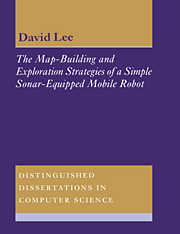 The Map-Building and Exploration Strategies of a Simple Sonar-Equipped Mobile Robot
The Map-Building and Exploration Strategies of a Simple Sonar-Equipped Mobile Robot Published online by Cambridge University Press: 05 March 2012
16.1 Motivation
Experience with human control of the exploration process suggested that map quality could be increased rapidly in the early stages of exploration by heading into open regions of space instead of staying close to one of the walls (Section 15.4). The ‘Longest Lines’ strategy described in this chapter was motivated by this observation. The essential idea is to perform a full sensor scan and head in the direction of the longest reading. As many steps as possible are then taken in that direction until an obstacle is encountered. The algorithm then continues by heading in the direction of the longest reading from this new position.
This strategy shares with wall-following the fact that it is totally reactive. Navigational decisions are made solely on the basis of the latest sensor readings.
Section 16.2 gives the details of the implementation and Section 16.3 compares the results to those of Wall-Following and Supervised Wall-Following. Section 16.4 summarises the experimental results and considers the strengths and weaknesses of the strategy.
16.2 Implementation
The strategy, as described in the previous section, is straightforward. The only slight complication is the problem of multiple reflections. Wall-following used the shortest range readings from each viewpoint; multiple reflections were not a problem because they typically cause long range readings. On the other hand, the ‘Longest Lines’ strategy is particularly interested in the long readings. It is therefore necessary to acknowledge the likelihood of multiple reflections and to compensate for them.
To save this book to your Kindle, first ensure [email protected] is added to your Approved Personal Document E-mail List under your Personal Document Settings on the Manage Your Content and Devices page of your Amazon account. Then enter the ‘name’ part of your Kindle email address below. Find out more about saving to your Kindle.
Note you can select to save to either the @free.kindle.com or @kindle.com variations. ‘@free.kindle.com’ emails are free but can only be saved to your device when it is connected to wi-fi. ‘@kindle.com’ emails can be delivered even when you are not connected to wi-fi, but note that service fees apply.
Find out more about the Kindle Personal Document Service.
To save content items to your account, please confirm that you agree to abide by our usage policies. If this is the first time you use this feature, you will be asked to authorise Cambridge Core to connect with your account. Find out more about saving content to Dropbox.
To save content items to your account, please confirm that you agree to abide by our usage policies. If this is the first time you use this feature, you will be asked to authorise Cambridge Core to connect with your account. Find out more about saving content to Google Drive.